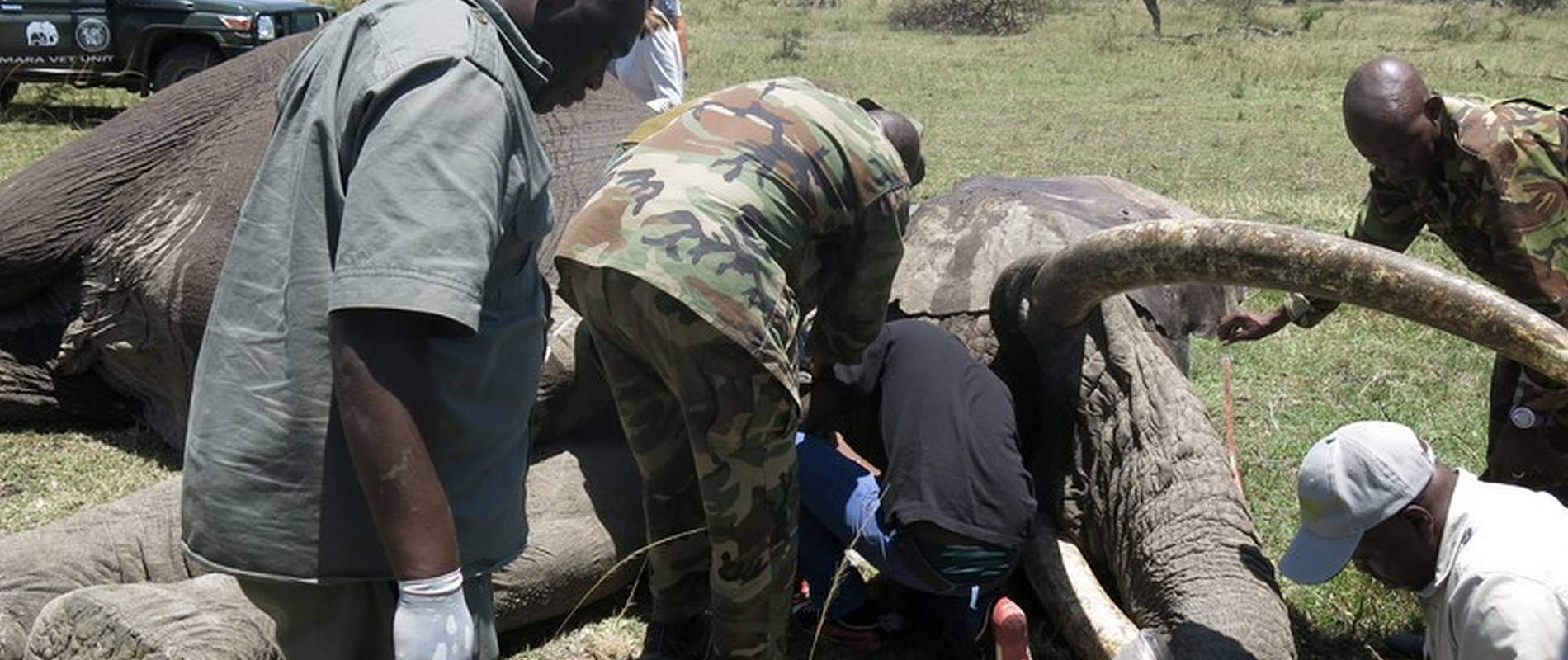FIELD VETERINARY REPORT FOR MASAI MARA FOR MONTH OF SEPTEMBER 2015 By Dr
FIELD VETERINARY REPORT FOR MASAI MARA FOR MONTH OF SEPTEMBER 2015
By Dr. Campaign .K. Limo
Introduction
Little rainfall was recorded in the conservation area during the period compared with the previous month. Migratory wildebeest are still around and have significantly reduced pasture that was abundantly available in the recent past. Incidents of human wildlife conflict cases are still being recorded with a nursing elephant cow being speared and an eland bull having a lodged arrow being attended to among other cases.
The following are cases handled during the month:
CASE#1 ELEPHANT COW WITH SPEAR WOUND
Date: 8th September 2015
Species: African elephant
Sex: Female
Age: Adult
Location: Ndonyo Rinka
History
This elephant in a herd of five others was seen by KWS and Mara elephant project rangers on patrol in the morning of this date, with freshly inflicted spear wound on her right shoulder. The wound was still bleeding. They called the mobile veterinary unit for intervention.
General examination
This elephant was in a small herd with some calves in a small thicket. She was the matriarch and although injured was very protective of the family. Her left shoulder had a fresh spear wound which was still bleeding.
Immobilization, examination and treatment
She was chemically restrained by use of 16mgs etorphine in a 3ml Dan inject dart through Dan inject darting system. Darting was done from a vehicle after briefly pushing the family out of the thicket. She appeared agitated initially but finally calmed as the drugs took effect. She was fully narcotized after ten minutes assuming left lateral recumbency. The rest of the family members were scared away by use of vehicles to allow the team access to the injured female.
Close examination revealed a deep freshly inflicted spear wound less than twelve hours old. The wound was about eight inches deep with ventro- medial course. It had sharp edges with approximately four inches diameter obviously caused by spear.
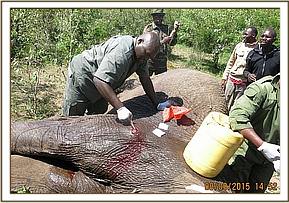
The wound was copiously lavaged with clean water and wiped with sterile swabs. Tincture of iodine was then introduced before green clay being packed for toxin absorption and prevention of sepsis. Oxytetracycline spray was also applied topically.
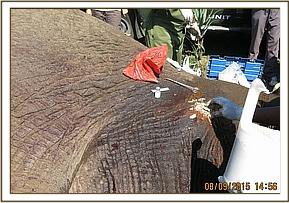
Additional treatments involved intramuscular administration of 22500mgs amoxicillin antibiotics prophylactically to prevent sepsis.
Reversal
Achieved by administration of 42mgs diprenorphine hydrochloride through a superficial ear vein. She came around in four minutes and traced the rest of the family members.


Prognosis
Good.
CASE#2 TREATING AN ADULT ELAND WITH AN ARROW WOUND
Date: 9th September 2015
Species: Eland
Sex: Male
Age: Adult
Location: Mara North Conservancy
History
This big bull in company of another male was spotted by Masai Mara Reserve and Mara North Conservancy rangers on their regular patrols with an arrow lodged on the left side of his neck. They called the mobile vet unit for help.
General examination
We found him in the company of another male close to a small bush. The shaft of the arrow was protruding on the left side of his neck and he appeared to be in pain with the area moderately swollen.
Immobilization, examination and treatment
Immobilization was achieved by administration of a combination of 10mgs etorphine hydrochloride and 60mgs azaperone tartarate delivered through a 3ml Dan inject dart.
Darting was done from a vehicle. Complete anaesthesia was achieved nine minutes after darting with the eland falling on his left side crushing the arrow shaft and pushing the arrow further deep. After putting in place a blindfold, and eye ointment to both eyes, this eland was flipped offer for easier examination of the injury and retrieval of the arrow.
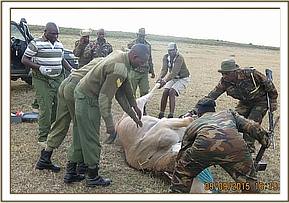
The arrow head could not be easily retrieved as it was barbed while the remainder of the shaft was already loose and was easily pulled out leaving the arrow head. The arrow appeared to tent the skin on the opposite side of the neck and after confirming indeed it was there, a small opening was created and the arrow worked out through the opening.
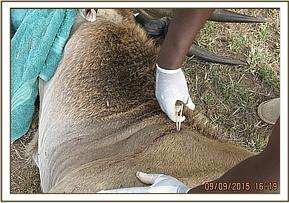

The resultant wound which was about three days old was cleaned with hydrogen peroxide, rinsed copiously with water and disinfected with tincture of iodine. Cloxacillin eye ointment was also infused into the wound. Additional treatments include parenteral administration of 6000mgs amoxicillin antibiotics and 30mgs dexamethasone sodium anti-inflammatory.
Reversal
This was achieved by intravenous administration of 30mgs diprenorphine hydrochloride delivered through the jugular vein. He woke up after seven minutes and re-joined his friend.
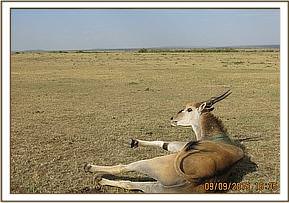

Prognosis
The arrow was not poisoned and did not damage vital organs hence this eland is expected to make full recovery.
CASE#3 RE-TREATMENT OF ‘SIENA’ THE FEMALE LIONESS
Species: African lion
Sex: Female
Age: Adult
Location: Musiara area (Mara National Reserve)
History
Siena had been treated for wounds sustained from territorial fights with other lions three weeks ago. This was the third time Siena was being treated for nasty wounds in a period of two years. Follow up treatment was therefore necessary in order to increase her chances of quick and complete recovery.
Immobilization, examination and treatment
Immobilization was achieved by use of a combination of 4mgs medetomidine hydrochloride and 200mgs ketamine in a 3ml Dan inject dart.Darting was done from a vehicle. After ten minutes, she appeared to be fully anaesthetized but rose up on approach. She appeared to quickly metabolise the drugs possibly because of frequency of immobilization. A top up dart of 2mgs medetomidine and 100mgs ketamine was prepared and successfully delivered after approaching on foot as she was partially drugged.
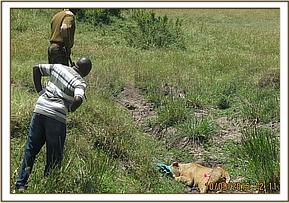
She was fully anaesthetized after four minutes and after moving her to a more comfortable place, examination and treatment commenced. All the wounds were clean and free of maggots. The wounds on the hindquarters had fully healed. The ones on the flanks were on their way to heal. The wounds were disinfected with tincture of iodine and cloxacillin antibiotic ointment applied. Green clay was then applied to hasten healing.


Additional treatments included parenteral administration of 3000mgs amoxicillin trihydrate antibiotics and 80mgs ivermectin parasiticide.
Reversal
Achieved by intramuscular administration of 15mgs atepamezole hydrochloride 45minutes after the last medetomidine/ketamine dose administration. She was fully awake by seven minutes and walked away without difficulty.


Prognosis
With the current condition, Sienna is expected to pull through and prognosis reviewed from guarded to good.
CASE#4 RE-COLLARING OF AN ELEPHANT BULL
Date: 11th September 2015
Species: African elephant
Sex: Male
Age: Adult
Location: Mara North Conservancy.
History
This big bull christened Hugo was collared more than two years ago and his collar was due for replacement before totally failing to transmit signal.KWS in collaboration with Save the Elephant and Mara Elephant Project together carried out this collar replacement exercise.
Immobilization and collar replacement
Hugo was found in an open area within Mara North Conservancy in company of another two big bulls. He appeared calm and hardly perturbed by our presence. Immobilization was achieved by use of 17mgs etorphine hydrochloride delivered through a 3ml Dan inject dart.Darting was done from a vehicle. It took eight minutes for this massive bull to be fully narcotized upon where he assumed sternal recumbency. He was then pushed to lie on his left lateral position for comfort and ease of breathing. Due to prevailing hot conditions, a lot of water was used to douse him in order to keep his body temperature within normal limits.
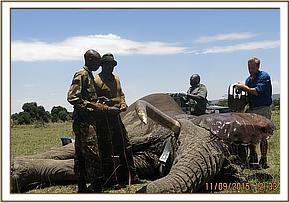
The old collar was then removed and new one deployed after its soundness being confirmed. This was a SAT/GSM collar that will transmit for the next three years giving details of Hugo’s movement and position for monitoring purposes. This was also an opportunity to examine a wound on Hugo that was treated two months ago which had completely healed. The procedure went on without any incident.


Reversal
Achieved by administration of 48mgs of diprenorphine intravenously through superficial ear vein. Hugo got up after seven minutes to join the rest of the bulls.


CASE#5 MALE ZEBRA WITH AN ARROW WOUND
Date: 16th September 2015
Species: Common zebra
Sex: Male
Age Adult:
Location: Masai Mara University
History
This lone zebra who for some time had become part of Masai Mara University community was reported by the University management to be having an arrow on the right side of his neck. They requested our services to help remove the arrow and treat this zebra.
General observation
This zebra was alone within the university farm, in pain and hardly feeding. An arrow head could be seen sticking out on the right side of his neck.
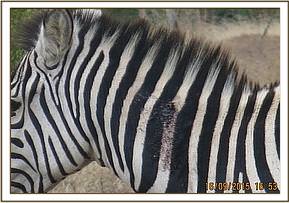
Immobilization, examination and treatment
He was immobilized by use of a combination of 5mgs etorphine hydrochloride and 50mgs azaperone tartarate in a 1.5ml Dan inject dart. Darting was done by foot. It took eight minutes for the drugs to take full effect.
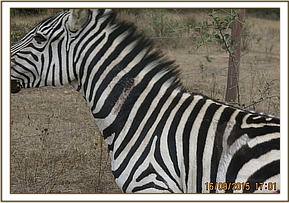
Examination revealed an arrow head stuck on the right side of his neck. It appeared to have been there for approximately two days and the wound was relatively fresh. The arrow was removed and the wound cleaned with copious amount of water, debrided with reconstituted hydrogen peroxide and disinfected wit tincture of iodine.
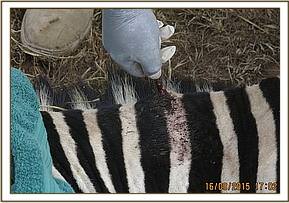
Additional treatment included parenteral administration of 3000mgs amoxicillin trihydrate antibiotic, 20mgs dexamethasone sodium anti-inflammatory and 80mgs ivermectin parasiticide. Because this zebra was lonely and his security not guaranteed, it was decided he be relocated to a secure place where other zebras were. He was taken some 30km where he was revived to join a group of other zebras.
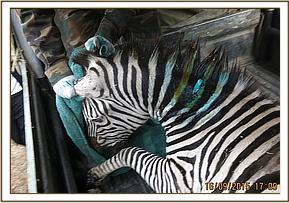

Reversal
Achieved by administration of 18mgs diprenorphine hydrochloride intravenously through the jugular vein.
Prognosis
Good
CASE#6 INJURED YOUNG MALE LION
Species: African lion
Sex: Male
Age: Young adult
Location: Masai Mara National Reserve
History
This injured young male was seen and reported to us by tourists visiting the reserve. They saw him with an injury on his tail and requested our services to save this lion.
General observation
On arrival, this lion was lying under a small shrub in company of another male. Proximal part of his tail was injured with an open wound partly exposing wings of coccygeal vertebrae.
Immobilization, examination and treatment
Immobilization was achieved by administration of a combination of 3mgs medetomidine and 200mgs ketamine in a 3ml Dan inject dart.Darting was done from a vehicle. An additional 1mg medetomidine and 50mgs ketamine was given as top up before treatment commenced. It took ten minutes for this lion to be fully anaethethized. Eye ointment was then applied to both eyes before blindfold being put in place. Examination revealed severe wound on the base of his tail likely caused by territorial fights with other lions. The wound was becoming septic with part of coccygeal vertebrae being exposed.
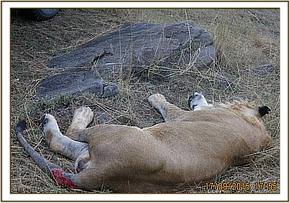
The wound was thoroughly cleaned with the help of hydrogen peroxide and clean water. It was then wiped dry with gauze swabs and disinfected with tincture of iodine. Finally oxytetracycline wound spray and a coat of green clay was applied. Additional treatments included intramuscular administration of 3000mgs amoxicillin antibiotic and 16mgs dexamethasone sodium anti-inflammatory. To take care of internal and external parasites, he received subcutaneous injection of 70mgs ivermectin parasiticide.
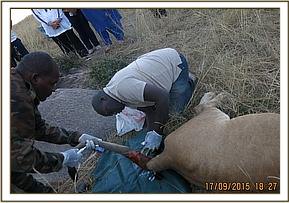

Reversal
Achieved by intramuscular administration of 15mgs atepamezole hydrochloride one hour after immobilization. He got up within ten minutes of administration and walked to join his colleague.
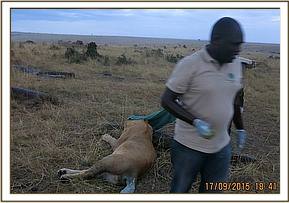

Prognosis
Favourable. Rangers were advised to monitor this lion and report progress. Review and repeat treatment will be done after two weeks. On a worst case scenario, tail amputation may be required.
CASE#7 AN INJURED MALE ELEPHANT
Species: African elephant
Age: Young adult
Sex: Male
Location: Olarro conservancy
History
This young bull was seen by Olarro conservancy management lagging behind the rest of the herd and seemingly limping. They called the mobile veterinary unit for assessment and treatment.
General examination and case management.
On examination, this elephant was alone and feeding. He appeared to drag his right hind limb while moving without any visible injury. The problem appeared to emanate from the hip joint with possible slight dislocation or sprain. After careful consideration, it was decided that immobilizing this elephant could cause more harm by aggravating the injury on falling. Since he could move and feed, close monitoring was advised and the problem is expected to resolve with time.
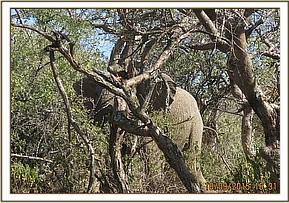
CASE#8 YOUNG FEMALE GIRAFFE WITH SNARE
Date: 26th September 2015
Species: Masai giraffe
Sex: Female
Age: Young adult
Location: Olkurruk/Kawaii
History
This giraffe thought to be harbouring snare on her right hind leg was seen by community scouts around Kawaii area. Together with Mara Triangle Conservancy rangers, they called the veterinary unit for action.
General observation
This giraffe in a herd of about twenty others was limping on her right hindlimb.The fetlock joint appeared swollen with a wound round it.No snare could visibly be seen but thought to be buried under the flesh.
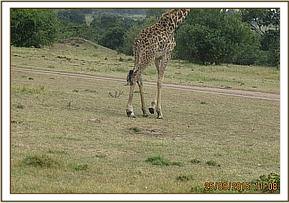
Immobilization, examination and treatment
Restraint was achieved chemically by use of a combination of 8mgs etorphine hydrochloride and 50mgs azaperone tartarate in a 1.5ml Dan inject dart.Darting was done from a vehicle. The drugs took full effect after eight minutes with the giraffe assuming left lateral recumbency. Examination revealed an old snare wound. The snare had since fallen. The wound was cleaned with copious amount of water, debrided with hydrogen peroxide then rinsed with clean water and wiped dry with sterile gauze. Tincture of iodine was used for disinfection.
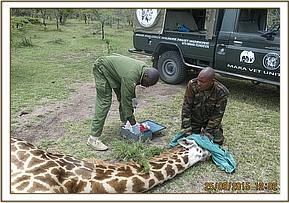

Additional treatments included, parenteral administration of 4500mgs amoxicillin trihydrate antibiotics and 1000mgs flunixin meglumine anti-inflammatory.
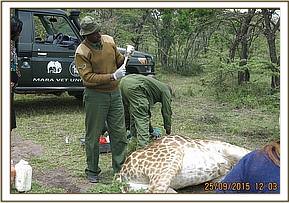
Reversal
Achieved by administration of 24mgs diprenorphine intravenously through the jugular vein. She rose immediately to join the rest of the herd.
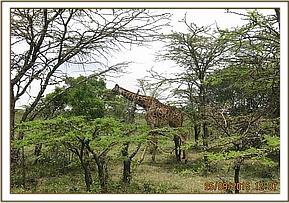
Prognosis
Good
CASE#9 EXAMINING TWO ADULT CHEETAHS FOR REPORTED ILLNESS
Date: 28th September2015
Species: Acinonyx jubatus
Age: Adults
Sex: Males
Location: Hammer kop area
History
These two cheetahs said to be brothers were seen by visiting tourists and Mara –Meru cheetah project teams. They had swollen cheeks and appeared lethargic. They called our mobile veterinary team and the Reserve management for help. They were said to have been in good condition three days before intervention.
General observation
Both cheetahs were seen resting by a Lugga in a small bush. One appeared seriously affected with obvious dyspnoea while the other one had mild swelling of both cheeks. They were seen to occasionally sneeze and cough with thick mucoid discharge from the nostrils. The more seriously affected cheetah showed more of abdominal breathing suggestive of lung and pleural congestion.
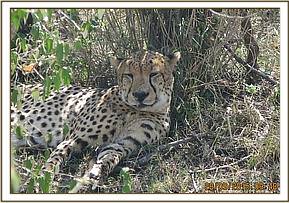

Case management
Clinical signs were consistent with those of cat flu which is a viral infection with varied outcomes. Due to the already compromised respiratory functions of these cheetahs, immobilization was considered too risky for them. Administration of drugs was therefore achieved by remote delivery using 3ml Dan inject darts. Each of the cheetahs received 300mgs clindamycin phosphate antibiotic. They will closely be monitored and their response reported for follow up treatment.
Conclusion
Mara mobile veterinary unit is grateful to all stakeholders who participated in one way or another in reporting and monitoring of animals treated during the period. Special thanks to Governor’s camp for their follow up on the treated lioness and constant update. Thanks too to Mara Elephant project teams for their role in tracing and help in treatment of injured elephants in the conservation area.
Many thanks to Minara foundation through The David Sheldrick Wildlife Trust for their continuous facilitation to the unit. Appreciation also goes to KWS management for their guidance to the unit and continuous collaboration with DSWT which has seen many wildlife species saved.
